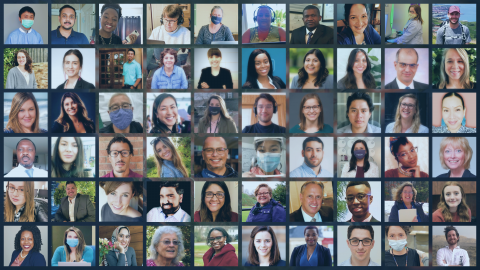You are here
From the outset, the COVID-19 pandemic has strained the nation’s health system. That strain has been felt acutely in the public health sector, where state, territorial, tribal and local health departments weakened by a decade of funding and staffing shortages often found themselves stretched to the limit.
The threat posed by COVID-19 sparked a massive national response. When the Centers for Disease Control (CDC) put out a funding announcement for help in bolstering public health capacity across the country, the CDC Foundation was quick to apply.
“We worked quickly to draft a detailed proposal relying on lessons learned from previous staffing projects,” said Turquoise Sidibe, associate vice president of emergency response at the CDC Foundation. “Once we received the award notification, we were off and running.”
Through that proposal, the CDC Foundation received an initial grant of $45 million from CDC to hire surge staff across the country—a monumental undertaking designed to bolster capacity in the nation’s frontline public health network. Between April 2020 and March 2021, the CDC Foundation filled critical positions, from contact tracers and case investigators to lab techs, data scientists and epidemiologists. This cadre, known as the CDC Foundation COVID-19 Corps, was in turn supported by a group of program managers, project managers and IT specialists.
“We were tasked with placing staff in 50 states plus territories, big cities and tribal jurisdictions,” said Kay Lawton, COVID-19 cooperative agreement surge team lead at the CDC Foundation. “In our first phase of hiring we placed 773 staff in 79 jurisdictions.”
To manage the corps of new workers, the CDC Foundation hired regional coordinators and senior advisors with deep public health experience, as well as the CDC Foundation’s first chief medical officer.
Hired as CDC Foundation employees to help understaffed health departments, these public health workers quickly proved their worth. At the end of the first phase of the staffing surge in March 2021, about 30 percent of the surge staff were either hired outright by their jurisdictions or retained through a CDC Foundation contract to remain in their jobs.
“We had a lot of cases where jurisdictions absorbed some of these staff so they wouldn’t lose them or hired staff directly with new resources that they had available,” Lawton said.
The impact and the outcome of the surge staffing has been profound.
n March 2021, the CDC Foundation received a $23 million extension of the initial cooperative agreement from CDC. While many jurisdictions used their initial funds to hire contact tracers and case investigators, the extension provided jurisdictions with the opportunity to hire staff in different job categories, addressing the needs of the shifting nature of the pandemic. In total, the extension funding was used not only to hire nearly 150 new staff country-wide, but to extend scores of others.
“The impact and the outcome of the surge staffing has been profound,” Lawton said. “We have received very positive feedback about the caliber of staff that have been hired and the contributions they are making, so that’s hugely important.”

In June of 2021, with new cases of COVID-19 increasing and vaccines being scaled up, the CDC Foundation received two new projects. The first project, funded for $200 million, was aimed at recruiting and hiring approximately 2,500 public health workers bridge gaps in public health workforces in state, tribal, territorial and local public health departments across the country.
Another project, funded for $20 million, was aimed at recruiting and hiring 300 immunization staff in 64 jurisdictions across the country to support vaccine distribution through state and local health departments. The projects helped secure critically needed staff, from data analysts, epidemiologists and case investigators to school support staff and public health nurses.
“The combination of vaccine rollout and increased cases in the fall of 2021 meant that jurisdictions needed additional support,” said Kathy Cahill, senior vice president for systems integration at the CDC Foundation. “Public health workers were burned out from the previous surge of COVID cases in 2020 and now were facing another round of new cases on top of vaccine hesitancy issues in many communities.”
While the pandemic’s impact has been unprecedented in modern public health history, so too has the response. As the nation’s healthcare network was overwhelmed by the sheer scale of COVID-19, public health workers hired by the CDC Foundation have stepped in to fill critical roles and bolster capacity at a time when help was needed most.
Learn more about our response efforts: visit the 2021 Donor Report
These projects are supported by the Centers for Disease Control and Prevention (CDC) of the U.S. Department of Health and Human Services (HHS) as part of three financial assistance awards totaling $288,939,536 with 100 percent funded by CDC/HHS. The contents are those of the author(s) and do not necessarily represent the official views of, nor an endorsement, by CDC/HHS, or the U.S. Government.